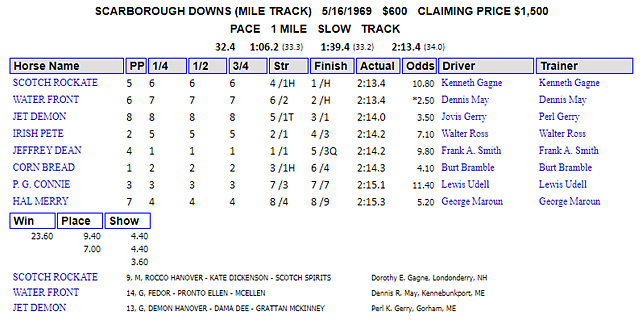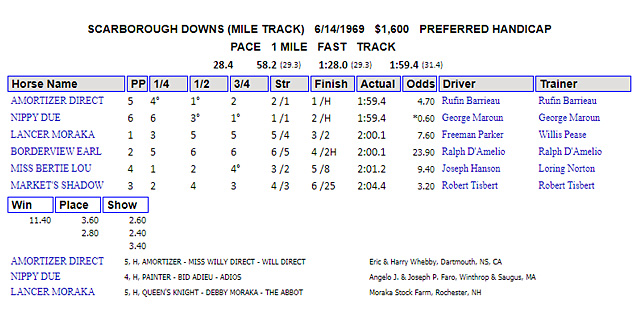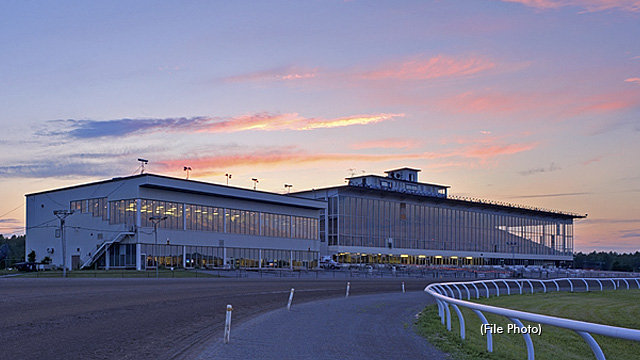Looking Back At Scarborough Downs
At around 3:15 p.m. on Saturday, we’ll know the name of the final winning horse in the 90-year history of Scarborough Downs. With that in mind, Bill McDonald of MEHarness.com looked back to 1969 and some of the harness racing firsts at the seaside oval.

Scarborough Downs was built in 1950 as a one-mile oval and hosted thoroughbred racing until 1972. In 1969, the Downs was sold to the Odgen Corp, which also owned Gorham Raceway. The new owners closed Gorham Raceway and brought harness racing to Scarborough Downs.
Opening day for harness racing was scheduled for Monday night, May 12, 1969. Many familiar Maine names ran the new racing operation. Arthur McGee was director of racing. Joining him were Tom Kiley (race secretary), Faye Nichols (clerk of the course), Zillah Witman (program director), Jim Flanagan (starter), and Dick Michelsen (announcer).
Drivers on the Downs’ first scheduled program included Dennis May, Don Richards, Frank Woodbury, Arthur Nason, Russ Smith, Russ Wing Jr., Willis Whittemore, Roy Gartley, J.D. Salley, George Fitch, Bobby Truitt, Irving Foster, Dominic Watson, and Al Langile Jr.
The track was dubbed the “all-new” Scarborough Downs by the Biddeford-Saco Journal, pointing to a $1.5 million renovation that included newly glassed-in grandstand and clubhouse, new “bank style” pari-mutuel windows, upgraded dining facilities, closed-circuit television, and air conditioning. “It’ll be like a posh nightclub,” said the track’s PR man, who noted that the new owners planned to add an “ultra-modern” hotel and golf course to the track’s 12,000 acres.
Four thousand fans came to the track to witness the first night, only to be disappointed when, 50 minutes before the scheduled 8 p.m. post time, the horsemen voted not to race due to the condition of the sloppy and deep track from major rains that, according to the Biddeford paper, had prevented the track from putting down stone dust.
The track’s statement was bitter: “Scarborough Downs management tonight felt our track was in condition to race. Horsemen who used the track today made no complaint to management until after the public had arrived.”
The Bangor Daily News sports editor, Owen Osborne, took the horsemen to task for the late cancellation, which didn’t sit well with Gerald MacKenzie Sr. of Plymouth, who wrote to the paper: “If Scarborough Downs was in such good shape, why was stone dust added to it? It looks as if more time was spent on the grandstand and grounds than on the most essential thing, the race track.”
It took four days to improve the track for racing and opening night was moved to Friday, May 16, 1969.
Five thousand fans attended opening night and wagered $150,169, a record for a 10-dash program in Maine. The first harness race in the track’s history was won by Scotch Rockate, in 2:13.4, with Ken Gagne driving and paying $23.60.

Track conditions plagued Scarborough during the first few weeks of the meet. The fastest mile on opening night was 2:08.1 on the mile oval, and it took three weeks to hit 2:05.0, recorded by Brilliant Rose with Al Langille, Jr. driving.
The final two weeks of the meet saw the race times getting faster. On the next-to-last race night, Tiger Hal paced the fastest race of the meet in 2:00.3 with George Maroun driving. Horsemen and fans were hopeful of a sub-2:00 mile on closing night, June 14.
Those hopes were fueled by the Faro brothers, Angelo and Joseph. Their horse, Nippy Due, had won two of the last three preferred handicaps at Scarborough, and with the better track conditions, they were confident in the win, bragging to anyone on the grandstand apron who would listen.
The Faro brothers' hopes were dashed as the Canadian import, Amortizer Drirect, driven by Rufin Barrieau upset the favourite in a classic stretch drive, hitting the wire in 1:59.4, the first sub-two minute mile since the Kite Track in Old Orchard Beach in 1942. The Bangor paper reported that the large crowd gave the winner a standing ovation.

At the height of Scarborough’s success in the 1970s and 1980s, the track saw record attendance and mutuel handles. Hall of Fame horses and drivers along with celebrities visited the track. Scarborough was the fastest half-mile track in New England for many years. Invitational races like the President's Pace and the Legislator Trot brought huge crowds to the track as some of the best horses in North America came to Scarborough Downs.
The track has struggled since 1993 with attendance and mutuel declines. Hopes for a rebound were dashed when the track could not persuade politicians and voters to allow a racino at the track. The grandstand fell into disrepair, the track's lights came down and the stable area closed. The recent sale of the property to a developer signaled that racing at the seaside oval would eventually come to an end, which was announced publicly on Nov. 19.

The future of Maine harness racing is up in the air. There are rumors of a new modern facility in Southern Maine, but nothing official has been announced as of now. The Scarborough foggy nights, when the backside couldn't been seen from the grandstand, may be a fitting backdrop for the future of harness racing in Maine.
(MEHarness.com)

